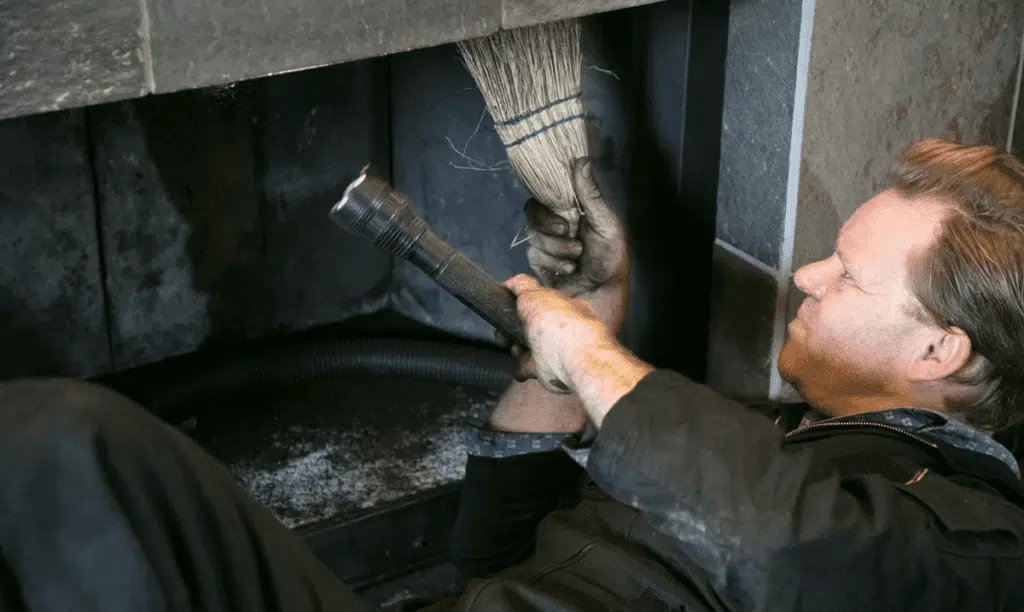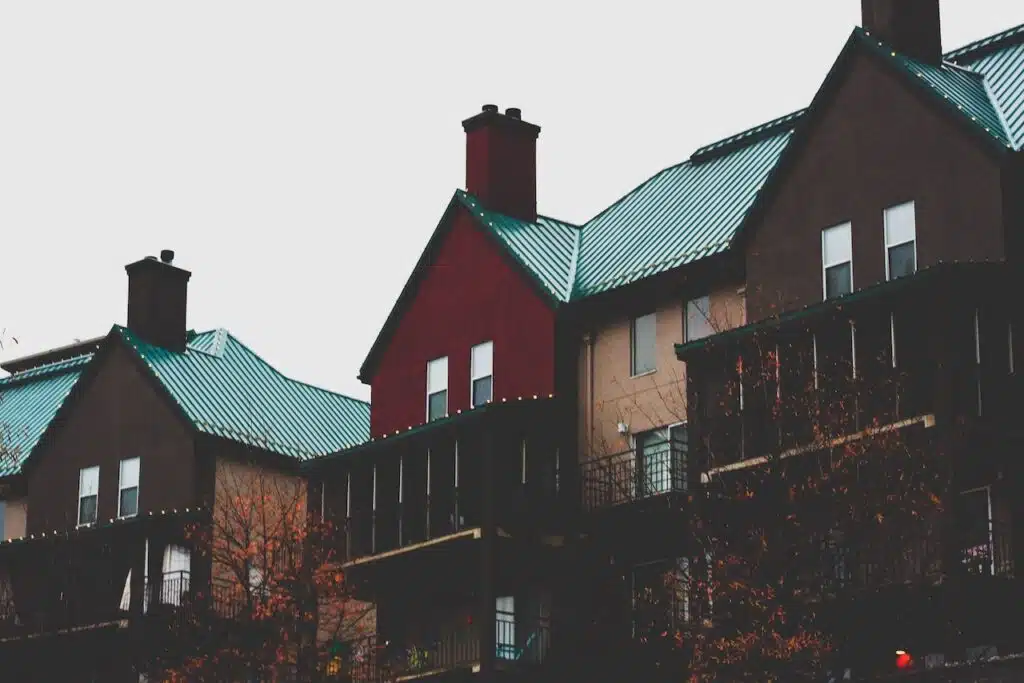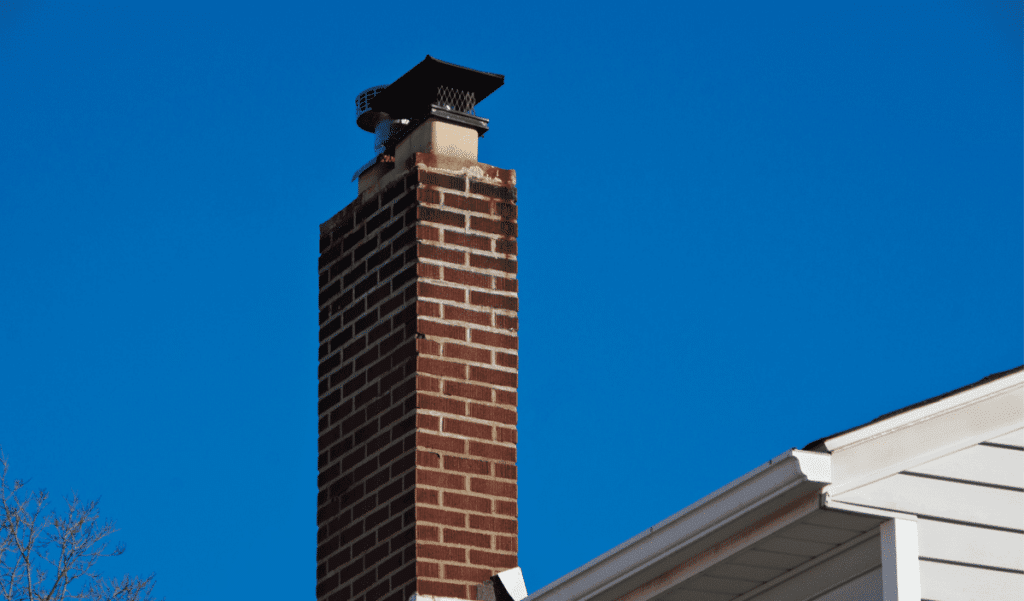
What is a Chimney?
A chimney is a vertical structure, usually made of bricks, that vents smoke and gas from fireplaces, stoves, or furnaces to the outside. It is an essential part of any heating system that burns wood, coal, oil, or gas.
Moreover, a chimney works by creating a draft that draws air through the heating system and out through the top of the chimney. Without it, smoke and toxic gases would build up inside your home.
Why Does a Chimney Need Cleaning?
Over time, chimneys accumulate debris such as soot, creosote (a flammable byproduct of burning wood), animal nests, leaves, and other materials. If not cleaned regularly, this buildup can obstruct airflow and create fire hazards. Creosote buildup in particular poses a significant risk as it can ignite easily and cause chimney fires that spread quickly throughout your home.
The Importance of Regular Chimney Cleaning
Regular chimney cleaning by trained professionals is crucial for maintaining the safety and efficiency of your heating system. Not only does it reduce the risk of fire hazards caused by creosote buildup, but it also ensures proper airflow to efficiently vent out toxic gases like carbon monoxide.
Additionally, regular cleaning can extend the lifespan of your chimney and heating system while saving you money on costly repairs in the long run. Don’t neglect this essential maintenance task – schedule regular chimney cleanings to ensure your family’s safety and comfort!
RELATED: Brushing Away the Soot: The Importance and Process of Chimney Cleaning Services
How Chimneys Get Dirty
Chimneys serve a vital purpose in our homes, but they also have the tendency to accumulate dirt over time. There are several reasons why a chimney may become dirty, and it is important to understand these causes in order to prevent future buildup.
One of the main causes of chimney buildup is creosote. This is a highly flammable substance that forms when wood and other fossil fuels are burned.
As the smoke rises up through the chimney, it cools down and condenses on the chimney walls, eventually forming a sticky, tar-like substance known as creosote. Over time, this buildup can become thick enough to cause blockages in the chimney, which can increase the risk of house fires.
In addition to creosote buildups, debris such as leaves, twigs, and animal nests can also accumulate inside chimneys. These materials can block airflow in the chimney and create additional fire hazards.
Animals like birds or squirrels often build their nests inside chimneys because they provide an ideal shelter from harsh weather conditions outside. While these may be cozy for them but for us humans, this creates a huge mess inside our chimneys.
Effects of Dirty Chimneys
Dirty chimneys not only pose safety risks but also have adverse health effects on both humans and pets. The most immediate danger posed by dirty chimneys is that of house fires due to creosote buildup or blockages caused by debris or animal nests inside the chimney. In addition to being dangerous, house fires can cause major property damage, which could be catastrophic.
Poor air quality within homes or buildings with dirty chimneys is another major issue caused by soot deposits within them as well as decreased efficiency of heating systems due to blocked airflow, which leads to inefficient burning of fossil fuels. The resulting smoke that enters your home through your fireplace or ventilation system contains harmful chemicals like carbon dioxide, carbon monoxide, and nitrogen oxides. Long-term exposure to these pollutants can lead to respiratory problems such as asthma and bronchitis, and can even cause heart disease over time.
It is essential to understand how chimneys get dirty and their effects in order to maintain a safe and healthy home or building environment. In the next section, we will go through the chimney cleaning process that professionals follow to keep your chimneys clean while ensuring maximum safety and efficiency for your heating systems.
Chimney Cleaning Process
Inspection and Evaluation Before Cleaning
Before beginning the cleaning process, it’s important to inspect and evaluate the condition of the chimney. A thorough inspection can help identify any potential issues or hazards that may need to be addressed before cleaning.
- This might include checking for cracks or other damage to the chimney structure, making sure there are no blockages in the flue, and assessing the level of buildup inside the chimney.
- The evaluation will also help determine which tools and techniques will be most effective for cleaning your specific chimney. For example, if there’s a lot of creosote buildup, a wire brush may be necessary to break up this stubborn material.
- Additionally, if animal nests have been found in your chimney, special care will need to be taken when removing them to avoid harming any animals still residing in them.
Tools and Equipment Used for Cleaning
Professional chimney cleaners use specialized tools to ensure that every aspect of your chimney is thoroughly cleaned. These tools can include brushes of various sizes (ranging from small hand brushes to larger rotary brushes), powerful vacuums for removing debris and creosote buildup, as well as specialized cameras that allow technicians to identify hard-to-see blockages.
The type of equipment used during cleaning will depend on several factors, such as the size and shape of your chimney or fireplace. For instance, if you have an older fireplace with a smaller flue opening than modern fireplaces generally have, then it may require different equipment than modern chimneys would need.
Steps Involved in the Cleaning Process
Once inspections have been conducted, equipment gathered and evaluated, it is time for a professional cleaner to get started with their job by following these steps:
- Setting up protective coverings around furniture or flooring near where cleaning will take place.
- Opening the damper to allow any debris to fall into the firebox.
- Use a powerful vacuum to remove as much loose debris and soot from the chimney structure as possible.
- Use special brushes (with slightly abrasive tips) to scrub away any tough creosote buildup from the interior of the chimney, starting at the top and working their way down.
- Once all surfaces have been brushed, a final vacuum is done to remove all loose debris that has accumulated in the bottom of the fireplace or stove.
- Finally, they will provide you with an evaluation report that includes any recommendations for future maintenance or repairs.
Benefits of Professional Chimney Cleaning Services
Safety and Health Benefits
One of the most important benefits of professional chimney cleaning services is that it ensures the safety and health of your family. A dirty chimney can lead to the buildup of creosote, which is a highly flammable substance that can cause a dangerous fire in your home.
Additionally, a dirty chimney can cause poor air quality, which can lead to respiratory problems and other health issues. Professional chimney cleaning services ensure that all creosote and debris are removed from your chimney, reducing the risk of fire hazards.
They also use high-quality equipment to get rid of any animal nests or other obstructions in your chimney, ensuring proper ventilation for clean airflow. By investing in professional chimney cleaning services, you are making an investment in the safety and health of your family.
Improved Efficiency of Heating System
Another benefit of professional chimney cleaning services is the improved efficiency of your heating system. A dirty or clogged-up chimney makes it difficult for smoke and gases to escape properly which results in low heating efficiency leading to higher energy costs. However, by getting regular professional cleanings this problem can be avoided.
When you invest in regular professional cleanings, you’re ensuring that your heating system runs smoothly without any blockages or inefficiencies. This not only saves you money on energy costs over time but also helps extend the life span of your heating system as well.
Long-Term Cost Savings
Investing in professional chimney cleaning services may seem like an added expense at first but it actually saves you money in the long run due to improved efficiency and prevention from hazards caused due to build-up. Regular cleanings will prevent damage caused by corrosion or cracks resulting from accumulated debris or chemicals inside chimneys.
In addition, investing in preventive measures ensures avoiding costly repairs over time during later stages when the damage could be severe. In this way, regular cleaning services are a cost-effective measure that not only saves you money but also keeps your family safe and secure.
RELATED: Clearing the Chimney: The Importance of Professional Chimney Cleaning Services
DIY Chimney Cleaning Tips
Safety Precautions to Take
Cleaning a chimney can be a daunting task, especially if you’re new to it. As with any home project, safety should be your number one priority.
Here are some safety precautions to take when cleaning your chimney:
- Wear protective gear such as gloves, goggles, and a dust mask.
- Use a sturdy ladder and have someone hold it steady while you climb up.
- Remove all ashes from the fireplace before starting the cleaning process.
- Make sure the damper is open and secure before starting the process.
These precautions will help keep you safe while cleaning the chimney.
Tools Needed for DIY Cleaning
Before you begin cleaning your chimney, make sure you have all the necessary tools handy. Here are some must-have tools for DIY chimney cleaning:
- Chimney brush – this is used to remove debris from inside the chimney walls.
- Drop cloth or tarp – this will protect your floor from debris that falls during the cleaning process.
- Vacuum cleaner with HEPA filter – this will help clean up any debris that falls onto your floor.
- Flashlight – this will help you see inside dark areas of the chimney.
Having these tools on hand will make DIY chimney cleaning much easier.
Step-by-Step Instructions for DIY Chimney Cleaning
Cleaning a chimney can seem like an intimidating task, but it’s actually quite simple if done properly. Here are some step-by-step instructions on how to clean your own chimney:
- Start by placing drop cloths or tarps around the fireplace area to protect your floor from debris.
- Open the damper in your fireplace and use a flashlight to look inside and assess how dirty it is.
- Attach the brush head to an extension pole and insert it into the chimney from the fireplace.
- Use an up-and-down motion to scrape the sides of the chimney while slowly pulling the brush back down to remove debris.
- Vacuum up any debris that falls onto your floor and dispose of it properly.
Following these steps will help ensure a successful DIY chimney cleaning experience.
Frequently Asked Questions
How often should chimneys be cleaned?
The frequency of chimney cleaning varies depending on the type of fuel used and how often you use your fireplace or stove. As a general rule of thumb, it is recommended that chimneys be inspected and cleaned at least once a year.
For wood-burning fireplaces or stoves, it may be necessary to clean the chimney more frequently, especially if you use your fireplace or stove often during the winter months. It is also important to have your chimney inspected and cleaned if you notice any unusual odors or smoke coming from your fireplace.
Can I clean my own chimney?
While it is possible to clean your own chimney, it can be dangerous and is not recommended for most people. Professional chimney cleaning services have the equipment and expertise necessary to safely remove creosote buildup and other debris from your chimney without damaging it. If you do choose to clean your own chimney, make sure you have the proper tools and safety equipment, including a sturdy ladder, gloves, goggles, dust mask, and a long-handled brush specifically designed for cleaning chimneys.
What are the signs that my chimney needs to be cleaned?
There are several signs that indicate that your chimney may need to be cleaned. The most obvious sign is excessive smoke coming from your fireplace or stove when in use.
Other signs include a strong odor coming from your fireplace or stove, black soot on the walls of your fireplace or stove insert, debris falling into your fireplace when in use (such as ashes or twigs), or birds nesting in your chimney. If you notice any of these signs, it’s important to schedule an inspection with a professional chimney cleaning service as soon as possible to avoid potential hazards like fires caused by creosote buildup.
Who pays for chimney cleaning?
The homeowner usually pays for chimney cleaning, as it is a part of regular home maintenance, similar to servicing a furnace or cleaning the gutters. Costs can vary based on the complexity of the cleaning and the region in which you live.
How often should I clean my chimney?
As a rule of thumb, you should clean your chimney at least once a year, typically in late summer or early fall before the colder months when you’ll be using your fireplace or heating appliance more frequently. However, if you notice a significant buildup of soot or creosote, or if you’re using your fireplace heavily, you may need to clean it more often.
Is it OK to clean your own chimney?
While it is possible to clean your own chimney, it’s important to note that it can be a messy and potentially dangerous job if not done correctly. Professional chimney sweeps have the necessary training and tools to clean a chimney safely and thoroughly.
How do I clean my chimney myself?
To clean your chimney yourself, you’ll need a chimney brush that fits your chimney size, some flexible rods to attach to the brush, a ladder, and safety gear such as goggles and a dust mask. After removing the damper, you scrub the interior of the chimney with the brush and rods from the top down, then clean up the soot and debris that falls into the fireplace.
What is the difference between chimney cleaning and sweeping?
Chimney cleaning and sweeping essentially refer to the same process: removing soot, creosote, and other obstructions from the chimney. However, some professionals use “cleaning” to indicate a more thorough service that may include inspecting the chimney for damage, while “sweeping” may be used for routine maintenance work.
What are the duties of a chimney sweep?
The duties of a chimney sweep include cleaning the chimney flue to remove soot and creosote, inspecting the chimney for structural issues or damage, and ensuring that the chimney cap and damper are functioning properly. They may also provide advice on safe fireplace use and maintenance.
Conclusion
It’s crucial to understand the importance of regular chimney cleaning services for the safety and efficiency of your home. Dirty chimneys can pose significant health and fire hazards, resulting in costly repairs or even life-threatening situations in extreme cases. By having your chimney cleaned regularly by professionals, you can ensure that your home is safe from these potential hazards.
In addition to the safety benefits, regular chimney cleaning services also improve the efficiency of your heating system. When creosote and debris build up in your chimney, it restricts airflow and causes your heating system to work harder than necessary.
This additional strain on your system leads to higher energy bills and reduces the overall lifespan of the equipment. By investing in regular cleaning services, you’ll enjoy long-term cost savings on both energy bills and repair costs.
Remember that while DIY cleaning is possible, professional chimney cleaning services use specialized tools and techniques to ensure a thorough clean that minimizes any potential risks or damage to your property. Don’t wait until it’s too late – schedule a professional chimney cleaning service today for a safer and more efficient home!






